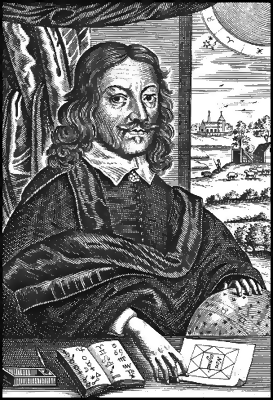 |
 |
|||
|
|
 Joseph Blagrave (1610-1679) Joseph Blagrave (1610-1679)Born: 1603 at Reading, Berkshire Astrologer Died: 1679 at Reading, Berkshire Joseph Blagrave was born in the parish of St. Giles in Reading, in 1610, the youngest son of the clothier and great chess master, Alexander Blagrave, and his wife, Margaret. He was the brother of Daniel Blagrave, the regicide, and a nephew of John Blagrave, the mathematician from whom he inherited a small estate in Swallowfield, five miles from his native town. Of his personal history, we have no knowledge beyond what is to be gleaned from a perusal of his books. His youthful years were spent in the study of astronomy and astrology, afterwards in philosophy and the practice of physic, upon which he writes, “Without some knowledge in astronomy one can be no astrologer, and without knowledge in astrology one can be no philosopher, and without knowledge both in astrology and philosophy one can be no good physician, the practice of which must be laid upon the five substantial pillars of time, virtue, number, sympathy and antipathy”. Blagrave married a lady named Susan in the late 1630s and they settled in St. Mary’s parish in Reading, but she died shortly after the birth of their only child, Joseph, in June 1640. The father’s first appearance as an author was in a series of 'Ephemerides, with Rules for Husbandly for the years 1658, 1659, 1660, and 1665'. No copy of the Ephemeris for 1658 is now preserved to us, as we learn from the volume for 1660 that “it came into but few hands, by reason of the slackness of the printer before it came forth.” The next work ascribed to him, 'The Epitome of the Art of Husbandry, by J. B., gent.' (1669). It was edited by his nephew, Obadiah, the son of Daniel Blagrave, and a bookseller at the sign of the Black Bear near the little north door in St. Paul's Churchyard. He published this and all the subsequent works of his uncle, two of which were posthumous. There followed: 'Blagrave's Astrological Practice of Physick' (1671); 'Supplement or Enlargement to Mr. Nich. Culpepper's English Physitian, to which is annexed a new Tract for the Cure of Wounds by Gunshot' (1674) - The preface to this work is dated from my house called Copt Hall, upon the Seven Bridges in Reading; and posthumously, his 'Introduction to Astrology' in three parts (1682). The interest attached to this last work is that it contains an engraved portrait of our author at the age of seventy-two years, and is dedicated to his friend Elias Ashmole, the antiquary. Blagrave had died in Reading in 1679 and was buried in St. Giles’ churchyard. Blagrave’s character appears to have been a curious mixture of earnest piety with a profound belief in the virtues of astrology. Of the various cures which he claims to have effected, one of the most curious is that of casting out a dumb devil from a maid at Basingstoke in Hampshire, where we are quaintly informed that, after invoking the name of the Tetragrammaton with that of the Blessed Trinity, “the devil came forth, but invisible, with a great cry and hideous noise, I raising a sudden gust of wind, and so vanished” The whole story is a curious study in the demonology of the seventeenth century. Edited from Leslie Stephen's 'Dictionary of National Biography' (1886).
|
|||
| © Nash Ford Publishing 2011. All Rights Reserved. | ||||


